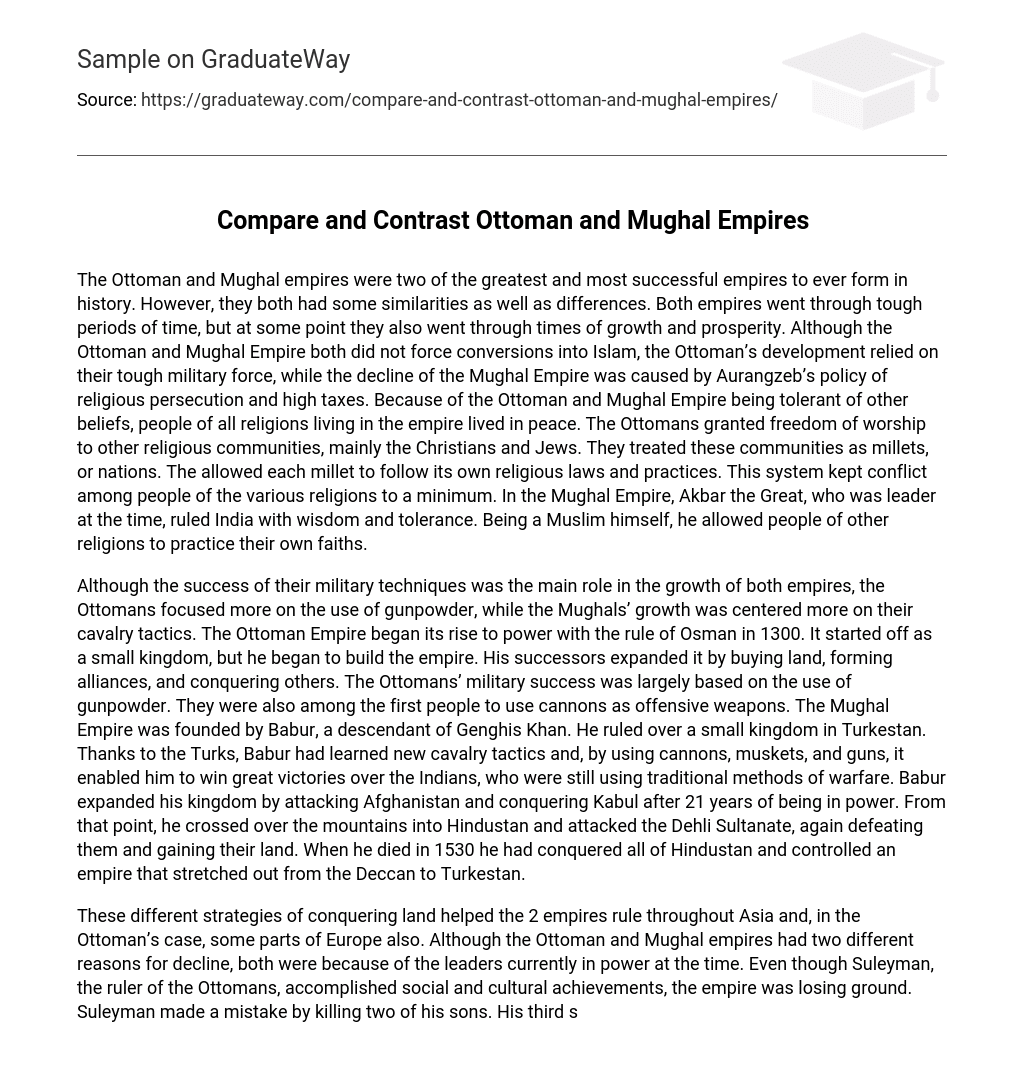The Ottoman and Mughal empires were two of the greatest and most successful empires to ever form in history. However, they both had some similarities as well as differences. Both empires went through tough periods of time, but at some point they also went through times of growth and prosperity. Although the Ottoman and Mughal Empire both did not force conversions into Islam, the Ottoman’s development relied on their tough military force, while the decline of the Mughal Empire was caused by Aurangzeb’s policy of religious persecution and high taxes. Because of the Ottoman and Mughal Empire being tolerant of other beliefs, people of all religions living in the empire lived in peace. The Ottomans granted freedom of worship to other religious communities, mainly the Christians and Jews. They treated these communities as millets, or nations. The allowed each millet to follow its own religious laws and practices. This system kept conflict among people of the various religions to a minimum. In the Mughal Empire, Akbar the Great, who was leader at the time, ruled India with wisdom and tolerance. Being a Muslim himself, he allowed people of other religions to practice their own faiths.
Although the success of their military techniques was the main role in the growth of both empires, the Ottomans focused more on the use of gunpowder, while the Mughals’ growth was centered more on their cavalry tactics. The Ottoman Empire began its rise to power with the rule of Osman in 1300. It started off as a small kingdom, but he began to build the empire. His successors expanded it by buying land, forming alliances, and conquering others. The Ottomans’ military success was largely based on the use of gunpowder. They were also among the first people to use cannons as offensive weapons. The Mughal Empire was founded by Babur, a descendant of Genghis Khan. He ruled over a small kingdom in Turkestan. Thanks to the Turks, Babur had learned new cavalry tactics and, by using cannons, muskets, and guns, it enabled him to win great victories over the Indians, who were still using traditional methods of warfare. Babur expanded his kingdom by attacking Afghanistan and conquering Kabul after 21 years of being in power. From that point, he crossed over the mountains into Hindustan and attacked the Dehli Sultanate, again defeating them and gaining their land. When he died in 1530 he had conquered all of Hindustan and controlled an empire that stretched out from the Deccan to Turkestan.
These different strategies of conquering land helped the 2 empires rule throughout Asia and, in the Ottoman’s case, some parts of Europe also. Although the Ottoman and Mughal empires had two different reasons for decline, both were because of the leaders currently in power at the time. Even though Suleyman, the ruler of the Ottomans, accomplished social and cultural achievements, the empire was losing ground. Suleyman made a mistake by killing two of his sons. His third son, the incompetent Selim II, inherited the throne. Suleyman set the pattern for the future sultans to gain and hold power. It became customary for each new sultan to kill his brother. This practice produced a long line of weak sultans who eventually brought ruin on the empire. Since India was mainly a land of the Hindus, The stability of the Emperor, in this case Aurangzeb, depended on the support of the people. Without their loyalty and cooperation, stability was impossible. When Aurangzeb came into power, he departed from the tradition of religious tolerance and persecuted the other religions living in his empire. Because of his harsh religious rules, most of the population revolted against him.
Aurangzeb’s religious policy weakened the foundation of the Mughal empire, therefore bringing it to an end. If one was to compare the two empires side by side, the Mughal Empire would have to be more successful than the Ottoman Empire. Whether through political, religious, or cultural struggle, these empires depended on their emperors for guidance and control. Although these empires aren’t present today, their legacies are still alive and have survived ever since. Their magnificent monuments and marvelous paintings are still admired every day by people around the world. The Ottomans and Mughals proved their dominance to the rest of the world, and to this day, are still being taught and studied for educational purposes.





